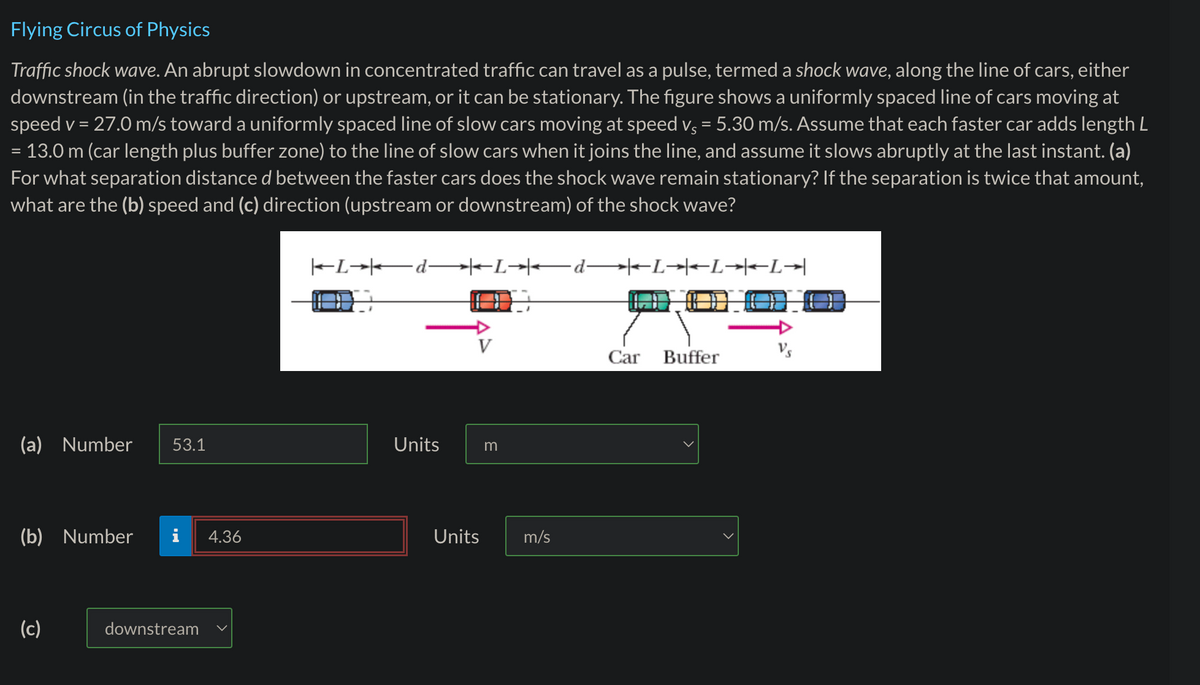Flying Circus of Physics Traffic shock wave. An abrupt slowdown in concentrated traffic can travel as a pulse, termed a shock wave, along the line of cars, either downstream (in the traffic direction) or upstream, or it can be stationary. The figure shows a uniformly spaced line of cars moving at speed v = 27.0 m/s toward a uniformly spaced line of slow cars moving at speed vs = 5.30 m/s. Assume that each faster car adds length L = 13.0 m (car length plus buffer zone) to the line of slow cars when it joins the line, and assume it slows abruptly at the last instant. (a) For what separation distance d between the faster cars does the shock wave remain stationary? If the separation is twice that amount, what are the (b) speed and (c) direction (upstream or downstream) of the shock wave? (a) Number 53.1 (b) Number i 4.36 (c) downstream LdLdLL L # IF V Units m Units m/s Car Buffer
Flying Circus of Physics Traffic shock wave. An abrupt slowdown in concentrated traffic can travel as a pulse, termed a shock wave, along the line of cars, either downstream (in the traffic direction) or upstream, or it can be stationary. The figure shows a uniformly spaced line of cars moving at speed v = 27.0 m/s toward a uniformly spaced line of slow cars moving at speed vs = 5.30 m/s. Assume that each faster car adds length L = 13.0 m (car length plus buffer zone) to the line of slow cars when it joins the line, and assume it slows abruptly at the last instant. (a) For what separation distance d between the faster cars does the shock wave remain stationary? If the separation is twice that amount, what are the (b) speed and (c) direction (upstream or downstream) of the shock wave? (a) Number 53.1 (b) Number i 4.36 (c) downstream LdLdLL L # IF V Units m Units m/s Car Buffer
Physics for Scientists and Engineers, Technology Update (No access codes included)
9th Edition
ISBN:9781305116399
Author:Raymond A. Serway, John W. Jewett
Publisher:Raymond A. Serway, John W. Jewett
Chapter3: Vectors
Section: Chapter Questions
Problem 3.62AP: After a ball rolls off the edge of a horizontal table at time t = 0, its velocity as a function of...
Related questions
Question
100%
I just need B since 4.36 is wrong

Transcribed Image Text:Flying Circus of Physics
Traffic shock wave. An abrupt slowdown in concentrated traffic can travel as a pulse, termed a shock wave, along the line of cars, either
downstream (in the traffic direction) or upstream, or it can be stationary. The figure shows a uniformly spaced line of cars moving at
speed v = 27.0 m/s toward a uniformly spaced line of slow cars moving at speed vç = 5.30 m/s. Assume that each faster car adds length L
= 13.0 m (car length plus buffer zone) to the line of slow cars when it joins the line, and assume it slows abruptly at the last instant. (a)
For what separation distance d between the faster cars does the shock wave remain stationary? If the separation is twice that amount,
what are the (b) speed and (c) direction (upstream or downstream) of the shock wave?
(a) Number 53.1
(b) Number
(c)
downstream
4.36
|LdL→→
Units
Units
m
m/s
dLL→L→
COO
Car
Buffer
Expert Solution
This question has been solved!
Explore an expertly crafted, step-by-step solution for a thorough understanding of key concepts.
Step by step
Solved in 3 steps with 13 images

Knowledge Booster
Learn more about
Need a deep-dive on the concept behind this application? Look no further. Learn more about this topic, physics and related others by exploring similar questions and additional content below.Recommended textbooks for you

Physics for Scientists and Engineers, Technology …
Physics
ISBN:
9781305116399
Author:
Raymond A. Serway, John W. Jewett
Publisher:
Cengage Learning

College Physics
Physics
ISBN:
9781938168000
Author:
Paul Peter Urone, Roger Hinrichs
Publisher:
OpenStax College

Principles of Physics: A Calculus-Based Text
Physics
ISBN:
9781133104261
Author:
Raymond A. Serway, John W. Jewett
Publisher:
Cengage Learning

Physics for Scientists and Engineers, Technology …
Physics
ISBN:
9781305116399
Author:
Raymond A. Serway, John W. Jewett
Publisher:
Cengage Learning

College Physics
Physics
ISBN:
9781938168000
Author:
Paul Peter Urone, Roger Hinrichs
Publisher:
OpenStax College

Principles of Physics: A Calculus-Based Text
Physics
ISBN:
9781133104261
Author:
Raymond A. Serway, John W. Jewett
Publisher:
Cengage Learning

Glencoe Physics: Principles and Problems, Student…
Physics
ISBN:
9780078807213
Author:
Paul W. Zitzewitz
Publisher:
Glencoe/McGraw-Hill